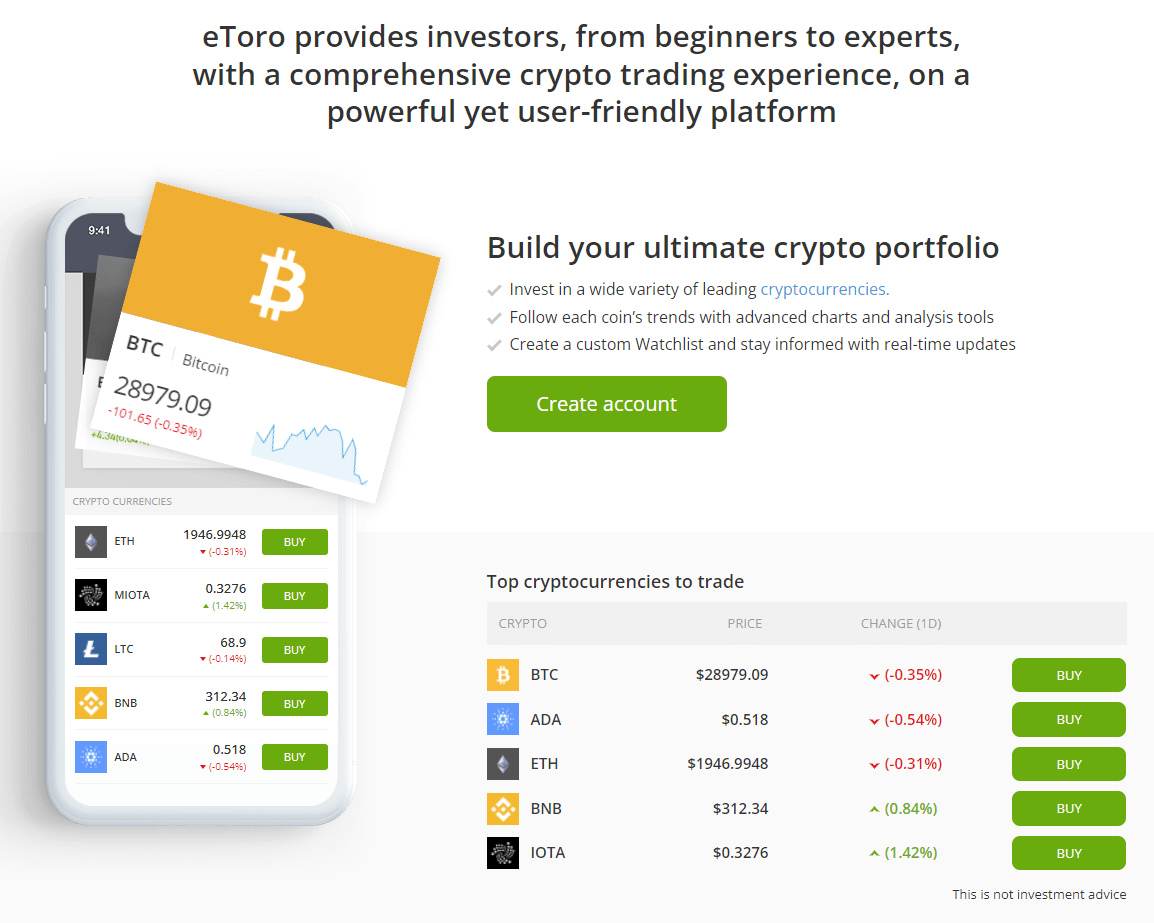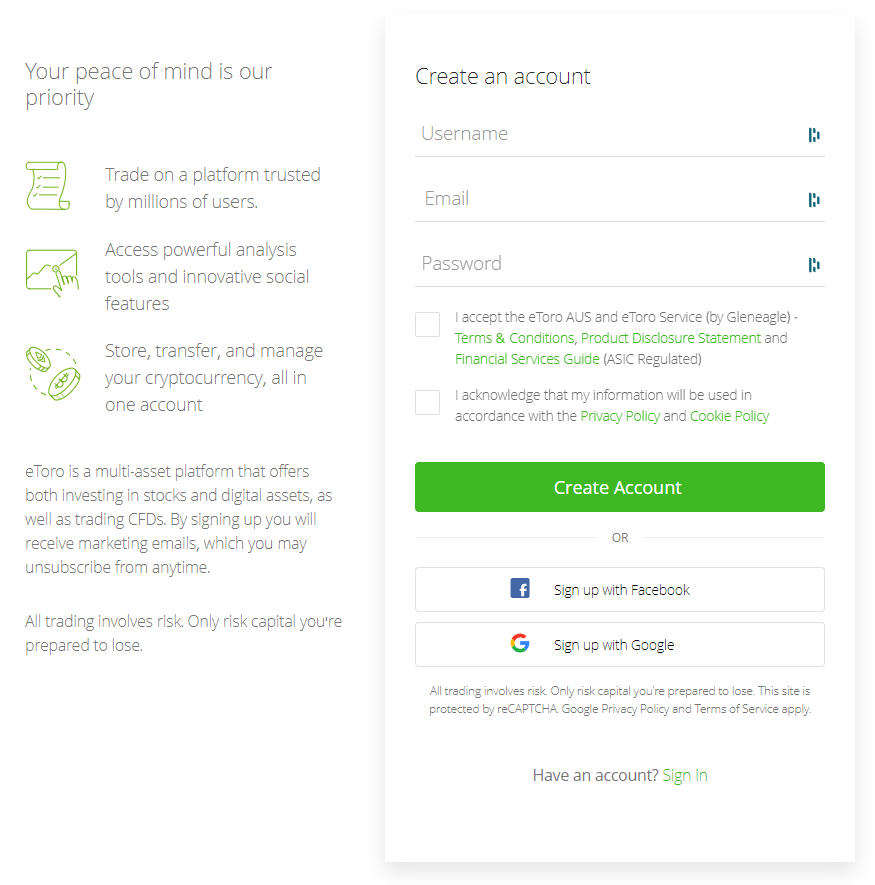How to Buy Crypto with NAB
Summary: While NAB doesn’t offer crypto trading on its own platform, you can easily use your account to buy crypto using a third-party cryptocurrency exchange.
There are plenty of Australian crypto exchanges to choose from, we recommend using eToro as the exchange to work with.
They have most of the popular cryptocurrencies available, are easy to work with, and have fantastic support!
Buy Crypto with eToro
[Rated 4.2/5 based on 15710 reviews on Trustpilot]
As mentioned above, just like most Australian banks, NAB doesn’t offer cryptocurrency trading directly, as setting up a cryptocurrency trading platform is quite complex and comes with regulations and extra requirements for the banks.
There are many crypto trading platforms that you can use for buying bitcoin and other cryptocurrencies.
Once signed up to an exchange (we’ll be using eToro for our example as it’s a widely trusted and global exchange), you can simply transfer funds from your bank account to the exchange, and trade it for crypto.
Table of Contents
How to buy crypto or bitcoin with NAB
There are only 4 steps involved, let’s get started!
1. Choose a crypto trading platform
As mentioned above, we’ll be using eToro for this guide as they are a widely used exchange and have over 50 cryptocurrencies to choose from. They also have a few really neat features like “Copy Trading”, which enables users to copy the trades of popular investors on the platform.
You can, of course, use any trusted crypto exchange for this, the steps will be very similar for most exchanges.
Let’s get started!
2. Sign up with the trading platform
The first thing to do is to sign up with the platform.
Once you’ve completed the initial sign up process, you’ll have to go through a quick verification process (also known as KYC).
3. Funding your account
Next up is funding your account. When it comes to depositing money to your eToro account, you have the option to use a bank transfer, PayPal, credit/debit card, and more.
4. Buy crypto
Finally, just go to the eToro Markets section, find the cryptocurrency you would like, and buy it.
And that’s it, it’s all pretty straightforward, now you know how to buy bitcoin or most other cryptocurrencies with NAB.
About NAB
NAB is the abbreviation of National Australia Bank. It is also known as nab. NAB was the 21st largest bank worldwide, measured by market capitalisation, and the 52nd largest bank globally in terms of total assets. NAB had 3,500 Bank@Post locations, including 7,000+ ATMs in Australia, New Zealand and Asia, as well as 9 million customers.
In 1982, National Bank of Australasia and Commercial Banking Company of Sydney merged to create National Australia Bank. The resultant company was later renamed National Australia Bank Limited.
Over the years, significant offshore expansion was triggered by the expanded financial base of merged entity. Representative offices were opened in Beijing (1982), Chicago (19branch 1982), Dallas (branch 1983), Seoul (1983), Seoul (1983), Kuala Lumpur (1884), Athens (1984), Frankfurt (1985), closed 1992), Frankfurt (1986), Atlanta (1986), Bangkok (1986), Taipei (1986), upgraded branch 1990), Shanghai (1988), Houston (1989), and New Delhi (1989).
NAB acquired Clydesdale Bank (Scotland), and Northern Bank (Northern Ireland, Republic of Ireland) in 1987 from Midland Bank. NAB changed the logos of both Midland Bank and Northern Bank branches to National Irish Bank in the Republic of Ireland. NAB purchased Yorkshire Bank (England & Wales) in 1990.
Additional acquisitions followed: Bank of New Zealand (in 1992), which had approximately 26% market share in New Zealand, and Michigan National Bank, 1995. NAB had previously rationalized its US operations and closed its San Francisco offices in Atlanta and Chicago in 1991.
The period of rapid expansion by acquisition ended with the 1997 acquisitions of HomeSide Lending (a leading US mortgage originator) and servicer, and, most importantly, the 2000 acquisition of MLC Limited (and related MLC entities), for $4.56bn. This was one of the largest mergers in Australian corporate history.
NAB faced a challenging period between 2000 and 2005. NAB sold Michigan National Bank in 2000 to ABN AMRO. Then, in 2001, HomeSide sold its operating assets to Washington Mutual for US$1.9b. Washington Mutual is the largest US savings company and loan company. It also owns the mortgage unit's loan servicing technology and operating platform.
The fraud in foreign currency trading was the catalyst that led to the resignations of Chairman Charles Allen and CEO Frank Cicutto. A Board revolt saw Catherine Walters emerge as a whistleblower, citing culture issues at the company that led to the succession of failures.
From 1999 to 2004, Frank Cicutto served as CEO of NAB. After 17 years of economic growth, the Australian economy was stable and productive under his leadership.
Following the dismissal of Cicutto, John Stewart was named CEO of NAB in February 2004. Stewart began a wide-ranging restructuring of the company on regional lines, which led to Ahmed Fahour being appointed CEO of Australia in September 2004. [14] Fahour was elected to the Principal Board and Group Executive Committee on February 20, 2009.
NAB announced in 2005 that it would cut 2,000 Australian jobs as part a global cost-cutting plan. It also planned to eliminate around 4,200 positions, or 10.5% of its total workforce worldwide. Accenture was the first company to begin outsourcing back office jobs offshore. It started with 23 jobs in Melbourne's accounts payable department and then moved to Bangalore, India, in an agreement. It sold the Northern Bank and National Irish Bank later that year to the Danish Danske Bank. In 2006, more than 200 jobs were sent overseas.
A new Australian head office was built in Docklands, Melbourne as part of the culture shift program. The building's open-plan layout is what makes it unique and was opened officially in October 2004. The Docklands Building was renamed 500 Bourke Street in 2009 to replace Cameron Clyne as CEO.
NAB reported a record $4.3 billion profit in 2006 and won two Bank of the Year awards. A major overhaul was also undertaken, including the renovation of all branches and the replacement of signage around National buildings and branches. The name of the bank was changed to 'nab.
NAB declared in May 2007 that it would be delisting from the New York Stock Exchange. This took place in August 2007. NAB was delisted from both the Tokyo and London exchanges in 2006.
NAB announced in March 2008 that it would provide maintenance and support to core banking applications in India via an offshoring agreement with Satyam and Infosys. This affected another 260 employees.
NAB's announcement on 25 July 2008 of an additional A$830 Million provision related to deterioration US real estate markets caused the largest single-day drop in the stock's share price in 21 year. It wiped out over A$7Billion from its value.
NAB launched UBank, a branchless bank trading separate from UBank in October 2008. It was led by Greg Sutherland (left) and Gerd Schenkel (right).
Cameron Clyne was appointed CEO in January 2009. He began a strategy for reputation management, wealth management, and a focus of domestic markets.
NAB's retail bank, which is underweight, attempted to increase market share under Lisa Gray's leadership by reducing fees and competing on price. Although the strategy initially hurt earnings in the division it produced mixed results over time. Cash earnings, market share, customer satisfaction, and cash earnings all increased, while operating margin and cost-to-income ratios declined. Both a positive as well as negative response was received to the campaign. Other major banks also responded quickly to the campaign. Cannes awarded the campaign an advertising award.
NAB tried to stand out from other "Big 4" Australian banks by launching a massive, national public relations campaign that focused on the theme of "breaking up" and other banks for Valentine's Day 2011.
Related:
 Author: Marco Vela -
Author: Marco Vela - 

